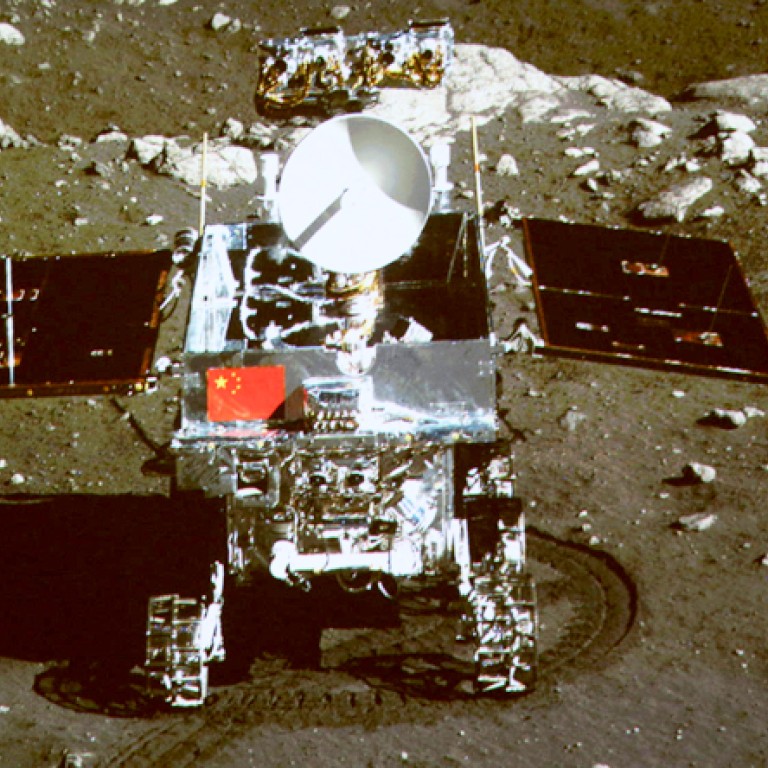
Last-ditch efforts to salvage mission of China's stricken Jade Rabbit lunar rover
Engineers identify power blockage as cause of Jade Rabbit's breakdown, which has left rover parked up on lunar surface for two months
Engineers are desperately trying to revive China's crippled lunar rover Jade Rabbit as fears grow that its mission could be over.
It broke down six weeks into its three-month mission in late January because of "mechanical control abnormalities".
And it has been parked up on the moon's surface for more than two months after travelling just 20 metres.
Engineers now say a blockage in the power circuitry is to blame and are looking to bypass it.
Professor Wang Jianyu, deputy secretary general with the Chinese Society of Space Research, said the electrical current was blocked "so the main driving mechanism cannot be powered up".
"It's like a clot in a human blood vessel [rendering] a body part immobile," he explained. Wang said aerospace engineers were still trying to determine what caused the "clot" and whether it could be resolved.
"The temperature on the moon is considerably lower than our previous estimation," he said, adding that certain components may be suffering from "frostbite".
He said the problem was confined to the driving mechanism. Scientific equipment on the rover, such as 3-D cameras, ground-penetrating radar and cameras, were functioning properly and constantly transmitting data to mission controllers
A design researcher at Beijing University of Aeronautics and Astronautics, Professor He Weiliang, said the challenges were complex.
All major electric components on a spacecraft have back-up systems, but they must be designed with a specific fault anticipated.
If a technical glitch disables a circuit, the current can be diverted to the back-up circuit to keep the vehicles powered up.
But he said: "The problem may be more sophisticated than just a 'clot'. Such a problem should have been considered in the design phase.
"I am afraid the problem is rooted in the reliability of certain devices or a system."
And Professor Gong Chunying, of Nanjing University of Aeronautics and Astronautics, who specialises in diagnosing electrical power system failures on spacecraft, said the "clot" could have been caused by a host of factors.
If the "clot" scenario had been addressed by the craft's designers, a back-up circuit could have been included to bypass the affected area, she said.
But she warned that the issue encountered by Jade Rabbit may relate to factors beyond those which the designers could have anticipated.
"If that is the case, the chances of repairing the rover will be diminished," she said.
Jade Rabbit, also known as Yutu, landed on the moon on December 14 - the first "soft landing" on the lunar surface since 1976. It first broke down on January 25.
China's space agency made an announcement concerning the problem and expressed fears that it may not be able to recover the mission.
Hopes were briefly raised when the lunar rover responded to controllers' commands - albeit with delays and difficulty - but it is currently incapable of activating its wheels or solar panels.
It remains unclear what effect the failure will have on the nation's wider space exploration ambitions.
The main purpose of the lunar programme was to send a large vehicle to the moon to retrieve samples and return them to earth in 2017.
One of the programme's long-term goals is to launch crewed missions to the moon and later establish a crewed lunar base.
No firm dates have been given, but some observers have said China could put a man on the moon in about a decade.
The lunar rover's power supply system was designed and built by the Shanghai Institute of Space Power Sources under the Shanghai Academy of Spaceflight Technology, according to previous reports by mainland media.
An administrative official with the institute said they were not authorised to reveal details about the vehicle.
"Yutu is only part of our work," said the official. "Our researchers are busy with many other big, important tasks."
According to the institute's website, its biggest project being carried out this year is to design the electrical power system for the space station, with construction scheduled to be completed by 2020.

